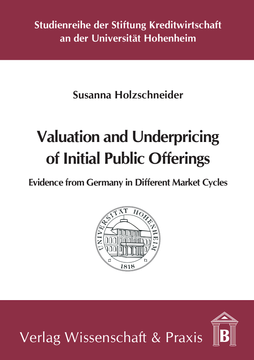Valuation and Underpricing of Initial Public Offerings

BOOK
Cite BOOK
Style
Format
Valuation and Underpricing of Initial Public Offerings
Evidence from Germany in Different Market Cycles
Studienreihe der Stiftung Kreditwirtschaft an der Universität Hohenheim, Vol. 48
(2011)
Additional Information
Book Details
Pricing
Abstract
This work investigates valuation and underpricing of initial public offerings at the German stock market from 1997 to 2007.When firms decide to complete an initial public offering (IPO) to raise new equity by issuing shares on a public stock market, their shares have to be priced to allow potential investors to be found. In almost every stock market across several countries the phenomenon of »underpricing« can be seen in the process of going public: share prices after the first day of trading are higher than the initial offering price.The German stock market was characterized by highly different market and going public conditions during the investigated time period. This allows to empirically analyse determinants of IPO valuation and underpricing within different market cycles. The work focuses on two major research questions: influence of pre-IPO ownership structures on the level of underpricing and the willingness to »leave money on the table« as well as effects of comparable firm multiples of already publicly traded firms on IPO valuation. The analysis shows that determinants and explanations of IPO valuation and underpricing change with different stock market cycles.
Table of Contents
| Section Title | Page | Action | Price |
|---|---|---|---|
| Vorwort | 5 | ||
| Table of Contents | 7 | ||
| Tables | 11 | ||
| Figures | 13 | ||
| Abbreviations | 14 | ||
| Introduction | 17 | ||
| Chapter I: Theory and Evidence of IPO Underpricing | 21 | ||
| I Introduction | 21 | ||
| II Theory and Evidence Based on Asymmetric Information Distribution | 22 | ||
| II.1 Information Asymmetries between Issuer and Investor | 22 | ||
| II.1.1 Signalling Theory | 22 | ||
| II.1.2 Certification of Quality | 25 | ||
| II.2 Information Asymmetries between Investors | 29 | ||
| II.2.1 The Winner’s Curse | 29 | ||
| II.2.2 Information Revelation | 32 | ||
| II.3 Information Asymmetries between Underwriter and Issuer | 37 | ||
| III Theory and Evidence Based on SymmetricInformation Distribution | 38 | ||
| III.1 Underwriter Price Support | 38 | ||
| III.2 Litigation Risk | 39 | ||
| III.3 Company’s Ownership Structure | 41 | ||
| III.4 Behavioral Finance | 43 | ||
| III.5 Information Momentum | 45 | ||
| IV Discussion | 46 | ||
| V Conclusion | 49 | ||
| Chapter II: How Do Pre-IPO Shareholders Determine Underpricing? | 51 | ||
| I Introduction | 51 | ||
| II Related Literature and Development of Hypothesis | 52 | ||
| III Research Design | 56 | ||
| III.1 Sample Selection and Data Sources | 56 | ||
| III.2 Definition of Variables | 57 | ||
| III.3 Definition of Hot and Cold Periods | 63 | ||
| IV Empirical Results | 63 | ||
| IV.1 Firm and Transaction Characteristics | 63 | ||
| IV.2 Pre-IPO Ownership Characteristics | 69 | ||
| IV.3 Regression Analysis | 74 | ||
| IV.3.1 Variables Explaining IPO Underpricing | 74 | ||
| IV.3.2 Determinants of IPO Underpricing in 1997-2001 and 2002-2007 | 79 | ||
| IV.3.3 Pre-IPO Ownership and Underpricing in Different Market Phases | 83 | ||
| IV.3.4 Pre-IPO Ownership and Underpricing with Positive Investor’s Information | 88 | ||
| V Conclusion | 96 | ||
| Chapter III: Do “Herding” Effects on Firm Multiples Determine IPO Valuation? | 97 | ||
| I Introduction | 97 | ||
| II Related Literature and Development of Hypotheses | 98 | ||
| III Research Design | 102 | ||
| III.1 Sample Selection and Data Sources | 102 | ||
| III.2 Methodology and Definition of Variables | 103 | ||
| IV Empirical Results | 108 | ||
| IV.1 Descriptive Statistics of Firm and Market Characteristics | 108 | ||
| IV.2 IPO’s and Comparable Firm Multiples | 114 | ||
| IV.3 IPO Valuation | 124 | ||
| IV.3.1 Regression Estimates on IPO Valuation | 124 | ||
| IV.3.2 IPO Valuation in Hot and Cold Markets | 127 | ||
| IV.3.3 Information Asymmetries and IPO Valuation | 132 | ||
| V Conclusion | 136 | ||
| Conclusion | 139 | ||
| References | 141 | ||
| Appendix: Chapter I | 153 | ||
| AI Information Asymmetries between Issuer and Investor | 153 | ||
| A I.1 Signalling Theory | 153 | ||
| A I.2 Certification of Quality | 156 | ||
| AII Information Asymmetries between Investors | 160 | ||
| A II.1 The Winner’s Curse | 160 | ||
| A II.2 Information Revelation | 164 | ||
| AIII Information Asymmetries between Issuer andInvestor | 166 | ||
| AIV Symmetric Information | 166 | ||
| Appendix: Chapter II | 173 | ||
| Appendix: Chapter III | 175 |
